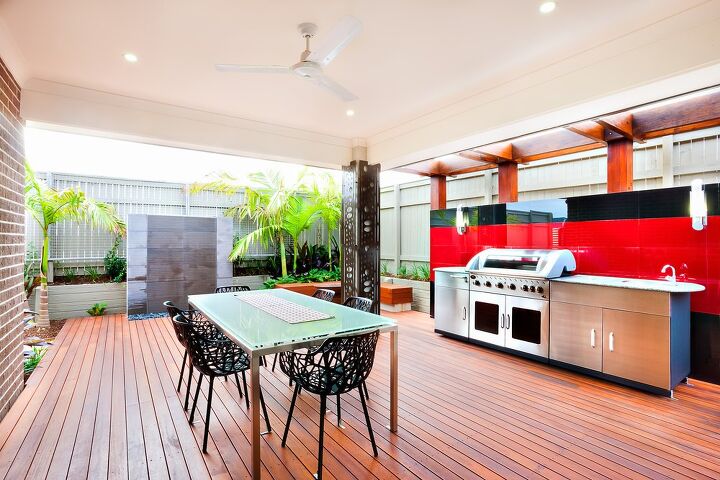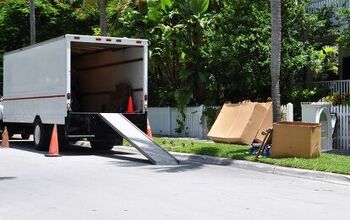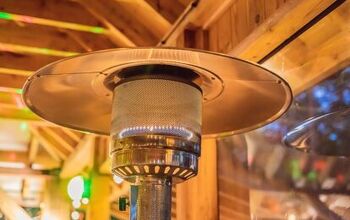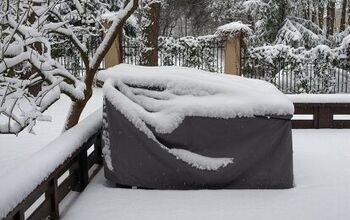Can You Grill Under A Covered Patio? (Find Out Now!)

If you enjoy grilling and spending time in your backyard, this question may have crossed your mind: can you grill under a covered patio in your yard? The answer isn’t very straightforward, but we believe there’s a clear way forward, nevertheless.
Yes, but using a grill on a covered porch is something you should do only if you’re totally aware of how the smoke will affect the space. In other words, you should only grill on a covered porch if there’s adequate airflow. Without good airflow, the smoke will get trapped, and trapped smoke leads to a variety of negative consequences.
As a general rule of thumb, you should not grill indoors, including underneath outdoor patio covers. On the other hand, you can store your grill in the garage or any other enclosed space. Here’s everything you need to know about safe grilling.
Do You Need Outdoor Kitchen Installation Services?
Get free, zero-commitment quotes from pro contractors near you.

What is a Patio Cover?
A patio cover is a structure that is attached to your home to provide shade over your patio space. There are a handful of different design options from which you can choose for your patio cover that offer varying levels of coverage, too. They are almost always only one-story tall and attached directly to your home.
What to Consider Before Bringing Grilling Appliances Indoors
The first thing you should consider before bringing barbecuing equipment inside are the emissions that these appliances generate. Traditional grills emit a lot of smoke, and so do pellet grills and smokers—this latter device is literally named after the emission it generates.
Where Smoke Goes When a Grill Is Brought Indoors
Smoke rises with hot air, and this isn’t something a lot of grillers focus on when grilling outside, as the smoke rises up and away into the atmosphere. But if you bring a grill inside, the smoke will not be able to dissipate as it does outdoors, and instead it’ll go right into the ceiling or covering that’s directly above it. If your ceiling/porch covering is routinely being bombarded with plumes of thick, black smoke, then a few negative consequences will be in your future:
Downsides of Grilling Indoors
Discoloring: If you’re grilling inside and the smoke doesn’t have easy access to the outdoors, it’ll be absorbed by the ceiling, walls, floors, and furniture. And when these fixtures and structural components take on smoke, they get discolored.
Smell: Discoloration isn’t the only thing you can expect from grilling inside. When the furniture and structural components inside absorb smoke, they’ll start to smell like smoke, often for days after you’ve finished grilling.
Often, remedying either of the situations above can be challenging. In the case of the residue that’s left by smoke, this can be hard to wash away, especially if it has built up for so long. And if you have seat cushions, wet clothes, or drapes in the area when you’re grilling, know that getting the smell of smoke entirely out of these items may be impossible.
Of course, if you like the smell of smoked meat a lot, you may not care about the smell. But the visual effects of prolonged smoke exposure are unattractive to everyone, so it’s best to avoid grilling in closed spaces.
Is Grilling on a Covered Porch Different From Grilling Inside?
Grilling on a covered porch is different from grilling inside the home, mainly because there’s more airflow in a covered porch. For this reason, grilling on a covered porch is for the most part permissible, provided the smoke doesn’t accumulate too quickly. But again, if the smoke is rising before it has a chance to exit your home, then it’ll probably hit the porch cover first, and we’ve already discussed what can result from this.
But not being able to vent smoke properly isn’t the only reason why you should ensure your grill is in a safe location. Grills run on fire and gas, which means placing this appliance in the wrong spot could create a hazardous situation. Here’s where you should put the grill if you intend to grill on your covered porch.
Where to Put the Grill
Place the grill so its backside is to the outside. If you can position the grill so its back is close to an open space—like the spaces between the railings—then the smoke will have a chance to go outside right when it exits the grill. Just remember that the grill should not be directly up against anything, as this placement could create a fire hazard—but more on this later!
Ceiling Clearance
If you’re grilling under a covered porch, you’ll need a certain amount of clearance between the grill and the porch cover. And if you’re using a pellet grill and smoker, having the right amount of clearance is even more important, in part because the smoker attachment rises above the top of the grill and therefore makes it taller.
To ensure you have the right amount of clearance, check your grill’s owner’s manual to see what’s recommended. And keep in mind that pellet grills and smokers collectively generate thicker, hotter smoke, and because of this you may need more clearance. Below are some basic measurements to keep in mind, but go with your manual’s recommendations if they differ.
Generally speaking, there should be 40 inches of space between the grill and the porch cover/ceiling. Additionally, the back of the grill must be at least 12 inches away from any railings or walls.
Charcoal Grill vs. Propane Grill
When grilling, you will either be using a gas-powered grill or a charcoal-powered grill. Both are suitable options for grilling a wide range of foods. They do differ in a few different areas, including prep and cook time, temperature control, cleanup, safety, and cost among other things.
For starters, it will take longer to cook with a charcoal grill, and it is more difficult to control the overall heat output. Moreover, they run hotter than propane grills and are much messier, too. When it comes to cooking underneath a cover, neither option is great, but a propane grill is technically better since it doesn’t get as hot and isn’t as messy. However, it is still not ideal.
Grilling Under a Screened-In Porch
You should never use a charcoal grill in a screened-in porch for a couple of different reasons. First, it poses an increased fire risk since charcoal fires are difficult to control. Even if all goes well, grilling in a screened porch will leave your space smelling very smoky.
While it is generally safer grilling with propane in an enclosed area, you still shouldn’t risk it. For starters, the gas that the grill emits can easily stain the ceiling and will be very difficult to clean. More importantly, it can cause an uncontrolled gas fire, which can be detrimental to your safety and the safety of your home.
Grilling Under an Awning
Awnings are safer than screened-in patios, but they are still not ideal for grilling underneath. However, if you are going to try it, use a gas grill. There are some general rules you should follow if you do though. First, make sure you have at least a 9-foot ceiling. This will leave a good amount of space for heat to escape from your semi-enclosed space.
You should also place the grill close to an outer wall that has better airflow, so you can properly vent the space. Also, you must be sure not to push the grill directly up against your home. On top of being a fire hazard, this can potentially mess up the outer surface.
Grilling Under a Carport
A carport is basically a combination between a garage and an awning. It is open-sided and is used as a shelter for vehicles. If you decide to grill under a carport, you should basically follow the same guidelines as grilling under an awning. However, it may not be as important to you if you stain the ceiling of a carport. This makes it a viable option if you find yourself wanting to grill on a rainy day.
Related Questions
How far should you be from your home when grilling?
At a minimum, a gas grill should be about 3 feet away from your home. However, the Consumer Product Safety Commission (CPSC) advises using both gas and charcoal grills at least 10 feet away from your home for maximum safety.
Can you grill underneath a tree in the yard?
Technically, yes, but it is not a good idea. Low hanging branches can be a hazard, especially when using a charcoal grill. Floating embers can very quickly turn into an uncontrolled fire, which can spread even faster if you live in a dry area.
How can you protect the ground when grilling?
To keep your surroundings as safe as possible, consider getting a grill pad or floor mat to set your grill on. These will protect your space from water, cause spills, grease, oil, and more.
Do You Need Outdoor Kitchen Installation Services?
Get free, zero-commitment quotes from pro contractors near you.

Final Thoughts on Grilling Under a Covered Patio
Though you technically can grill under a covered patio in certain scenarios, you should avoid doing it in any case. There are too many things that can go wrong even when following safety precautions.
Instead, find an open area that is a good distance away from your home or any other structure that an open flame can harm. Doing this will not only ensure your safety but also the structural integrity of your covered patio.

I am a copywriter and editor based in the Las Vegas area with nearly a decade of experience under my belt writing landing pages, cost guides, blog posts, newsletters, case studies, and social media content. I have a degree in Strategic Communication and experience working in both the account and creative spheres. My goal is to always be discovering new interests and bettering myself as a writer and editor along the way.
More by Kerry Souder



























